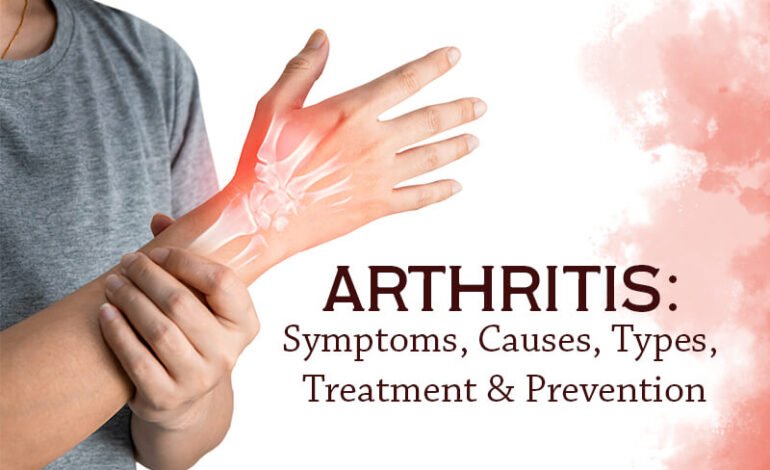
Arthritis types & how it’s cured & Precautions?
Arthritis is a general term that refers to a group of more than 100 diseases that affect the joints — the places where two or more bones meet. These conditions cause inflammation, pain, stiffness, and swelling in the affected joints, and in some cases, can lead to a decrease in joint mobility and function.
Types of Arthritis:
- Osteoarthritis (OA): The most common type, OA is a degenerative joint disease that occurs when the cartilage, the cushion between bones, breaks down over time. It usually affects weight-bearing joints like the knees, hips, and spine.
- Rheumatoid Arthritis (RA): An autoimmune condition where the body’s immune system attacks the synovium (lining of the joints), leading to inflammation. RA typically affects joints on both sides of the body, like wrists, knees, and fingers.
- Psoriatic Arthritis: A form of arthritis associated with the skin condition psoriasis. It can cause joint pain and swelling, typically in the fingers, toes, and spine.
- Gout: Caused by a buildup of uric acid crystals in the joints, often in the big toe, leading to sudden, severe pain and swelling.
- Lupus (Systemic Lupus Erythematosus): An autoimmune disease that can cause arthritis along with other symptoms, such as skin rashes, fatigue, and kidney problems.
- Ankylosing Spondylitis: A type of arthritis that primarily affects the spine, leading to stiffness and pain. Over time, this condition can lead to the fusion of the spine.
- Juvenile Arthritis: A type of arthritis that affects children, leading to joint pain, swelling, and stiffness. It includes several subtypes like systemic, oligoarticular, and polyarticular arthritis.
- Infectious (Septic) Arthritis: Caused by an infection in the joint, typically from bacteria. It leads to sudden, severe joint pain, swelling, and fever.
Cure for Arthritis:
While there is no cure for arthritis, the condition can often be managed effectively through treatments aimed at reducing symptoms and improving quality of life. Treatment methods may include:
- Medications:
- Pain relievers (acetaminophen, NSAIDs) for pain management.
- Disease-modifying antirheumatic drugs (DMARDs), especially for rheumatoid arthritis, to slow down the disease progression.
- Biologic agents to target specific immune system components in autoimmune types like RA.
- Steroids to reduce inflammation.
- Physical Therapy: Helps strengthen muscles around the joint, improve flexibility, and reduce pain.
- Surgery: In severe cases, surgery may be required, including joint replacement (like hip or knee replacement) or arthroscopy to repair joint damage.
- Lifestyle Changes: Weight management (for OA), exercise, and diet changes can help improve joint function and reduce symptoms.
Precautions:
- Regular Exercise: Low-impact exercises such as swimming, cycling, and walking can improve joint flexibility and strength without putting too much strain on the joints.
- Healthy Diet: Eating an anti-inflammatory diet can help manage symptoms. This includes plenty of fruits, vegetables, whole grains, and healthy fats (like omega-3s from fish).
- Weight Management: Maintaining a healthy weight reduces stress on weight-bearing joints, such as the knees and hips, particularly for OA.
- Proper Posture: Using proper posture when sitting, standing, or lifting can reduce stress on joints and prevent further damage.
- Avoid Overuse of Joints: It’s important to rest and not overstrain the joints, especially during flare-ups of arthritis.
- Assistive Devices: Wearing supportive shoes, using joint braces, or using tools like reachers or canes can help reduce strain on affected joints.
- Manage Stress: Chronic stress can exacerbate inflammation, so practicing relaxation techniques like meditation, yoga, or deep breathing exercises can be beneficial.
- Regular Medical Check-ups: Monitoring the condition with your doctor to adjust treatments and prevent complications is key to managing arthritis effectively.
Conclusion:
Arthritis, while not curable, can be managed with a combination of medical treatment, lifestyle changes, and physical therapies. It’s important to work closely with a healthcare professional to determine the best approach based on the type of arthritis and its severity. Regular exercise, healthy eating, weight management, and joint protection techniques can help reduce pain and improve mobility.



